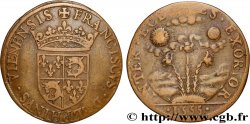E-auction 641-646314 - DAUPHINÉ - FRANÇOIS II, DAUPHIN François II, dauphin 1555
Devi Sign-in ed essere un offerente approvato fare un'offerta, Login per fare offerte. Conti sono soggetti ad approvazione e di approvazione sono raggiunti entro 48 ore. Non aspettare fino al giorno di una vendita si chiude per registrarti.Confermando la tua offerta su questo oggetto ti impegni ad un contratto legalmente vincolante per l'acquisto di questo prodotto e fare clic su «offerta» costituisce accettazione dei termini di utilizzo de e-auctions cgb.fr.
Offerta deve essere collocato in euro gli importi interi vendita only.The si chiuderà al momento sulla descrizione dell'oggetto, eventuali offerte pervenute al sito dopo l'orario di chiusura non verranno eseguite. Volte transmition possono variare e le offerte potrebbero essere respinto se si attende per gli ultimi secondi. Per ulteriori informazioni ckeck le FAQ.
SENZA COSTI PER GLI ACQUIRENTI.
SENZA COSTI PER GLI ACQUIRENTI.
Tipo : François II, dauphin
Data: 1555
Metallo : ottone
Diametro : 28 mm
Asse di coniazione : 9 h.
Peso : 4,41 g.
Orlo : lisse
Marchio : sans poinçon
Grado di rarità : R1
Commenti sullo stato di conservazione:
Patine hétérogène avec une forte usure, quelques coups et rayures. Taches d’oxydation
N° nelle opere di riferimento :
Diritto
Titolatura diritto : + FRANCISCVS. DELPHINVS. VIENENSIS..
Descrittivo diritto : Écu écartelé aux 1 et 4 de France, aux 2 et 3 de Dauphiné sous une couronne ouverte.
Traduzione diritto : (François, dauphin de Viennois).
Rovescio
Titolatura rovescio : + INTER. ECLIPSES. EXORIOR. - 1555.
Descrittivo rovescio : Trois tiges de lis naturel entre le soleil et la lune.
Commento
Deux exemplaires identiques se trouvent, l’un dans la collection Chaper, l’autre au Cabinet des médailles de Paris. De Bie, Histoire de la France métallique, Paris, 1636 donne la description suivante du revers : “le corps est de trois lis tigés naissans de terre, au-dessus desquels paroist en la région de l’air un soleil en aspect sextil avec la lune”.
Two identical examples are found, one in the Chaper collection, the other in the Cabinet des médailles in Paris. De Bie, Histoire de la France métallique, Paris, 1636 gives the following description of the reverse: “the body is three stemmed lilies arising from the earth, above which appears in the air region a sun in sextile aspect with the moon”
Two identical examples are found, one in the Chaper collection, the other in the Cabinet des médailles in Paris. De Bie, Histoire de la France métallique, Paris, 1636 gives the following description of the reverse: “the body is three stemmed lilies arising from the earth, above which appears in the air region a sun in sextile aspect with the moon”








 Segnalare un errore
Segnalare un errore Stampate la pagina
Stampate la pagina Condividi mia selezione
Condividi mia selezione Fai una domanda
Fai una domanda Consegnare / vendere
Consegnare / vendere
 Descrittivo
Descrittivo







